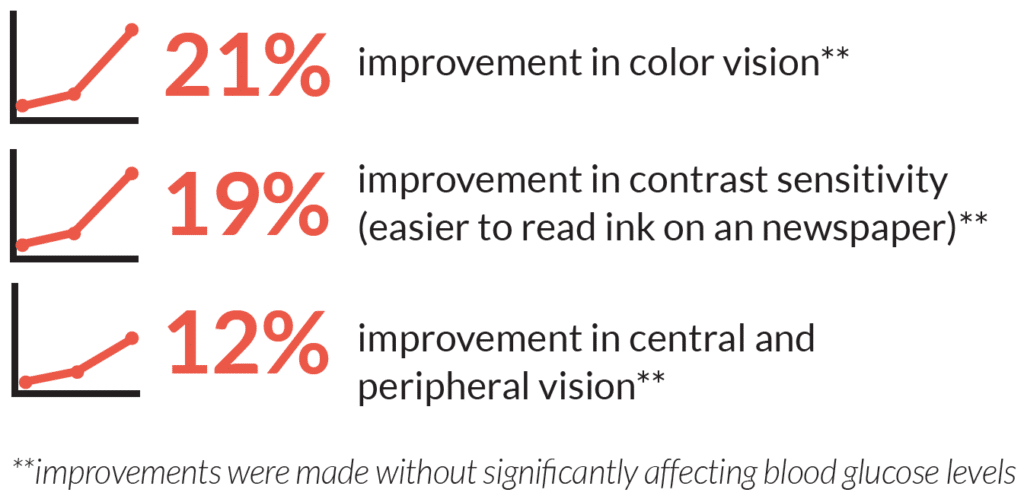Co-Managing Patients with Blood Glucose Control Issues
Posted by amess on Sep 27th 2018
Blood glucose control is becoming a growing concern among many Americans. In fact, nearly 30.5 million people have issues with blood glucose, and even worse, one in four don’t know. Optometrists (ODs) can help with this statistic, though. Almost a quarter of patients who know they have trouble controlling their blood glucose levels were told so by an OD. Eye exams can help identify those patients at risk for or currently with blood glucose control issues, and ODs, primary care physicians (PCPs), and ophthalmologists (MDs) need to work cohesively to effectively manage these patients.
 DVS provides the nutrients necessary to combat the process of eye health degradation without impacting normal blood glucose levels. Though this and other lifestyle changes help protect patients’ vision, arrange co-management with a specialist in the event that eye health worsens.
DVS provides the nutrients necessary to combat the process of eye health degradation without impacting normal blood glucose levels. Though this and other lifestyle changes help protect patients’ vision, arrange co-management with a specialist in the event that eye health worsens.
Fill them in on what you expect of them. Equip them with what they need to explain and sell your new testing equipment and products. They’ll need to ask for the PCP’s address, phone number, and fax number and a short blood glucose-related history, which should take about 1 minute once your staff is comfortable asking the questions:
Blood Glucose-Related Eye Care in Your Practice
Blood glucose control concerns usually cause problems in the eyes before it impacts vision or before a patient even knows about it. By the time visual function concerns arise, it's already taking its toll. Daniel Ephstein, OD, FAAO, shared his opinion on incorporating eye care related to blood glucose control into his practice.“Not only is taking care of these patients by addressing their [blood glucose issues] the right thing to do; it’s a great practice-builder.”The number of known patients with blood glucose concerns is steadily growing, and while the hope is that this health issue will eventually decrease, it’s best to equip your practice with the tools and equipment to support this patient type. Dr. Ephstein suggests that ODs include a slit lamp and indirect ophthalmoscope in their practices as basic blood glucose-related eye care.
Offer the Best Care
For “truly high-quality care,” Ephstein recommends having fundus photography and OCT imaging. Fundus gives a clear image of what’s going on deep in the eye, and OCT can detect little changes that fundoscopy could miss. Another method of early detection is macular pigment optical density (MPOD) measurement. The QuantifEye® MPS II is the industry-standard MPOD measurement instrument, and with 97% repeatability and accuracy, the QuantifEye can identify low macular pigment levels, which can be an indicator of more serious concerns. Often, specialists and MDs won’t recommend solutions for patients with mild eye health concerns. It’s up to ODs to keep a watchful eye on patients’ vision and blood glucose-related care: good blood glucose and pressure control, a healthy diet, and regular exercise. Nutrition is an incredibly important factor when it comes to eyesight in patients with diabetes. Offering an eye health nutraceutical that’s been proven to improve visual function in those with blood glucose control issues can offer another way to control the worsening of associated eye health concerns. EyePromise® DVS is the only visual function-focused nutraceutical for patients with irregular blood glucose control backed by an FDA clinical trial which showed: DVS provides the nutrients necessary to combat the process of eye health degradation without impacting normal blood glucose levels. Though this and other lifestyle changes help protect patients’ vision, arrange co-management with a specialist in the event that eye health worsens.
DVS provides the nutrients necessary to combat the process of eye health degradation without impacting normal blood glucose levels. Though this and other lifestyle changes help protect patients’ vision, arrange co-management with a specialist in the event that eye health worsens.
Blood Glucose Care & Co-Management
While adding the right products gets you started, there are a few more steps when integrating blood glucose-related eye care into your practice.Make appointments with PCPs and MDs to discuss possible referral relationships.
When you meet with them, explain what services you provide and how you can help their patients. Make sure they know that you can return the favor and refer your patients who need PCPs or MDs.Equip your practice staff.
- How long have you had issues controlling your blood glucose levels?
- What type of blood glucose control issues do you have?
- What was your last blood glucose reading?

